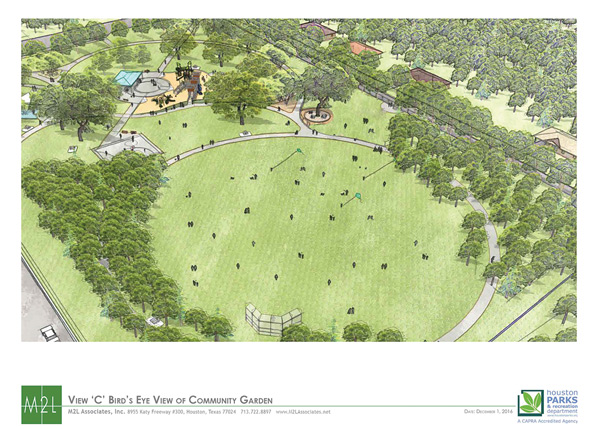By Steve Wright, Parks and Recreation Director, City of Houston
A revitalization project is underway at Busby Park, a 5.83 acre Houston Parks and Recreation Department greenspace located on Hirsch Street in the northeast part of the city. The improvements to the park are bound to help make the surrounding neighborhood more livable as well as boost property values.
The very history of Busby Park is intertwined with the sustained efforts of Houston community leaders to rejuvenate the Trinity Gardens community in which the park is embedded. Before it was acquired by the City of Houston in 1979, Busby Park was known as Bennington and Hirsch Park and was an apt symbol of the dilapidated state into which the Trinity Gardens neighborhood had fallen: the property was overgrown with weeds and surrounded on all sides by houses in disrepair. It was one J.A. Busby who agitated for four years for the City of Houston to assume management of the park and make it into a place his community could be proud of. On October 20, 1979, the park, by then under city stewardship, was rechristened Busby Park.

Steve Wright
Parks and Recreation
Director, City of Houston
The Houston Parks and Recreation Department, in partnership with ProUnitas and Zieben Group, is now renewing its commitment to Trinity Gardens by using an $830,000 Texas Parks and Wildlife Department Urban Outdoor Grant to completely renovate Busby Park. According to the City of Houston, the TPWD grant is supplemented by $1,039,441 in Park Consolidated Construction Funds and $39,100 in Parks and Recreation Dedication Funds, so that the total funding for the Busby Park development is $1,908,541. Right now Busby Park consists of a pavilion, three walking paths, a playground, swing sets, and a large field with a backstop that takes up about half the lot. The project, which broke ground on January 11, 2018, involves, according to the City of Houston, “construction of a 2,151 linear foot trail system; a half basketball court; an outdoor shaded exercise area with two elliptical stationary workout stations, one stationary recumbent workout bike and one upper body strength workout station; fencing along the southern portion of the park site[;] a new playground unit to 2-5 years old and swings […] trail lighting and electrical upgrades; a new picnic pavilion with lighting, picnic tables, benches and drinking fountain; landscaping with associated irrigation and the planting of 210 trees.” This ambitious project involves a complete overhaul of all the park’s infrastructure, state-of-the-art play and exercise equipment, and lighting and irrigation systems that will help ensure Busby Park will be a pleasant place to spend time for the people of Trinity Gardens.
One can also expect that the revitalization will positively impact Trinity Gardens as a whole. As Michael Isermann, Deputy Director of Facility Management and Development at the Houston Parks and Recreation Department says, “The Busby Park renovation project will bring a new source of pride and a sense of community to the ever-changing Houston Parks system. Patrons will now visit a modernized version of their park offering new recreational experiences and encouraging future generations to build long lasting memories. Memories which will become part of the historical fabric of Trinity/Houston Gardens and the surrounding community.”
The benefits that Isermann is predicting will perhaps be best measured by looking at the property values of the surrounding area, and indeed one can expect that the land around Busby Park will increase in value as a result of this renovation project. It is common knowledge that there is a statistically significant relationship between property value and distance from a park. To cite just one case study, the Urban Institute reports that, in a 1974 study, “the value of properties near Pennypack Park in Philadelphia increased from about $1,000 per acre at 2,500 feet from the park to $11,500 per acre at 40 feet from the park.” The presence in parks of facilities for “passive recreation,” such as benches or walking paths, is especially likely to increase property values, according to a study by I-Hui Lin of the University of Wisconsin-Milwaukee. And renovations on existing parks have also been shown to have a unique influence on the value of surrounding land. According to Mitchell Levy and H. Allen Klaiber of Ohio State University, replacing playground equipment was found to have a significant, positive influence on the property values of the neighborhoods surrounding the 203 parks they studied for at least four years after the renovation projects were completed. It’s easy to see why these phenomena are observed: parks have a non-trivial impact on quality of life. Greenspaces improve neighborhoods by giving the residents something to look at and by giving them a place for recreation and socializing that is near their homes and does not cost money to use. Parks are part of the social infrastructure for a neighborhood: they are a natural space to hold parties, weddings, and other events that bring communities together. Moreover, parks serve as gathering places for potential customers for local businesses, so that stores, restaurants, and other establishments of public accommodation are encouraged to set up shop near parks, further raising the demand for land near the park and making homes more valuable on account of their proximity to these resources. It is reasonable to expect that the revitalization of Busby Park will have these effects in the Trinity Gardens community.


